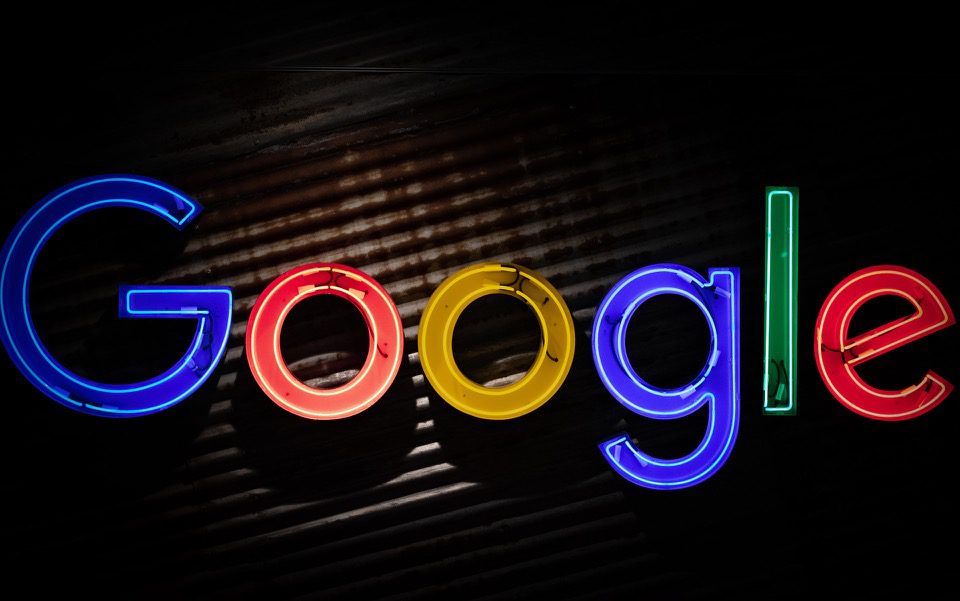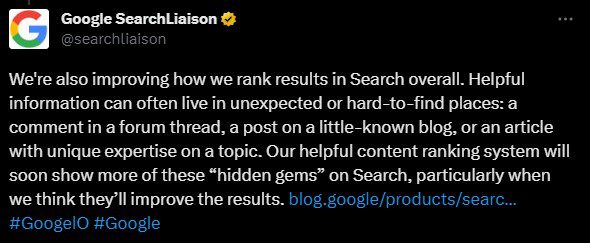
Google’s search algorithm is constantly evolving to better serve the needs of changing user behaviors and technological advancements. With hundreds of updates each year in an effort to improve search results and create a satisfactory user experience, there’s no wonder why Google has captured a significant portion of the market.
The first Helpful Content Algorithm Update by Google finished rolling out on September 9th 2022, and was soon followed by another iteration in December 2022 which further refined the classifier and extended its capabilities to non-English languages.
In May 2023, we were teased by yet another set of adjustments to the Google Helpful Content update that seeks to reward content with unique expertise and uncover “hidden gems”. The exact date hasn’t been revealed yet but it will be rolled out sometime in the coming months.
What does this new update entail for your business and how can you prepare for it? With Google controlling over 90% of the worldwide search engine market, this is an important question to consider if you want your SEO efforts to bear fruit and your website to dominate the top of the Search Engine Results Page (SERP).
In this blog, we’re sharing everything we know about this new update so far and how you can adapt your future content strategy to find success with the upcoming changes.
Table of Contents
- 1 What Is the Google Helpful Content Update?
- 2 How Does the Helpful Content Algorithm Update Work?
- 3 Greater Focus On Content With Unique Expertise
- 4 Importance of E-E-A-T for Crafting Original Content
- 5 What Does This Mean for Your SEO Strategy?
- 6 Is Your Content People-First or SEO-First?
- 7 Adapting Your SEO Strategy for the Google Helpful Content Update
- 8 Future-Proof Your SEO With Coalition Technologies
What Is the Google Helpful Content Update?
The Helpful Content algorithm update is a part of Google’s larger efforts to provide users with valuable content and a satisfying search experience. This system generates a sitewide signal that promotes original, people-centric content and demotes low-value content that has been written with the sole purpose of climbing the search results. The goal is to display information that’s genuinely helpful and meets users’ search intent and expectations.
How Does the Helpful Content Algorithm Update Work?
The Helpful Content algorithm is a fully automated, machine learning model also known as a “classifier” that categorizes content as either helpful or unhelpful. With this Google Helpful Content update, websites with large amounts of unhelpful content perform poorly on search results and lose their organic visibility, whereas websites deemed as offering helpful content are rewarded with a higher ranking. But simply offering high-value content isn’t enough because the classifier also looks at other aspects of the page such as the content length, structure, formatting, accessibility, and the overall user experience.
The signals generated by the classifier are weighted, so every time the classifier detects unhelpful content, it stores this information for future evaluations. Google’s Helpful Content update documentation says that, “Any content—not just unhelpful content—on sites determined to have relatively high amounts of unhelpful content overall is less likely to perform well in Search”. However, “some people-first content on sites classified as having unhelpful content could still rank well if there are other signals identifying that people-first content as helpful and relevant to a query”.
Greater Focus On Content With Unique Expertise
GWI reported that the primary intent of 57.8% of internet users is to find information. They want accurate answers to their query, delivered in a concise and engaging manner. The new Google Helpful Content update will better understand original content created from a personal or expert point of view in order to offer more relevant information to users.
This new Helpful Content algorithm update will improve search results by:
- Focusing more on content with unique expertise and first-hand experience.
- Enriching results with content from hard-to-find places such as discussion boards, Q&A sites, social media, comments, and lesser-known blogs.

To this effort, Google also announced a new feature, ‘Perspectives’ that will allow users to filter results and only display information that comes from personal experiences rather than rehashed knowledge that has been published only to gather more clicks.
Importance of E-E-A-T for Crafting Original Content
With the second iteration of the Google Helpful Content update in December 2022, the tech giant added ‘Experience’ as an additional search assessment criterion to their Quality Raters’ Guidelines. E-A-T is now ‘E-E-A-T’, also dubbed as ‘Double E-A-T’.
In addition to expertise, authoritativeness, and trustworthiness, this updated Helpful Content algorithm benchmark also assesses whether the content on a website demonstrates “that it was produced with some degree of experience, such as with actual use of a product, having actually visited a place or communicating what a person experienced”. For example, if you want information on the latest SEO strategies, you’ll want to see content produced by a Subject Matter Expert (SME) like Coalition Technologies which has worked with thousands of clients and has valuable insights derived from hands-on experience.
In these guidelines for the Google Helpful Content update, the search engine has also emphasized the fundamental principle of trustworthiness that the Search is centered around. Expertise, authoritativeness, and experience are necessary for capturing the nuances of how individuals seek information and the diverse sources and formats in which helpful information can be found. But all of these ultimately circle around unearthing accurate and reliable information.
What Does This Mean for Your SEO Strategy?

The upcoming Google Helpful Content update will remain faithful to the initial objective, all the while stressing the significance of crafting unique content that is reliable and showcases both authority and expertise. If you’re an SEO strategist or a business owner, this would mean modifying your strategy to craft compelling content that’s written for people by people.
The impact of the Helpful Content algorithm update has been nowhere near that of core updates like Florida and Panda, but Google has made it clear time and again that the era of keyword-stuffing and writing for search engines is long past and it’s time to refocus on the original purpose with which search engines were developed. Taking measures to stay aligned with the new Google Helpful Content update now will ensure your SEO efforts remain future-proof.
Is Your Content People-First or SEO-First?
Pivoting your SEO strategy in compliance with these new updates requires a better understanding of what helpful content is and what it isn’t. In its guidelines, Google has described helpful content as being:
- People-first content that satisfies user intent with original insights from SMEs.
- Optimized with the best SEO practices to enhance overall user experience.
Our WordPress SEO Guide and Shopify SEO Checklist go more into detail about all the SEO best practices you can put into action immediately to comply with the Google Helpful Content update and get your website ranking. The platform you use for your business might differ but the strategies shared in these two posts will be applicable to it as well.
Auditing your website’s current content is an important step in determining how you should strategize your future content for the Helpful Content algorithm update. The table below summarizes the traits shared by Google that helps distinguish people-centric vs search engine-first content.
| People-Centric Content |
|
| Search Engine-First Content |
|
If your content or website matches the traits in the left column, congratulations! You’re creating people-centric content that’s relevant, informative, and Google Helpful Content update-compliant. Any content that’s specific, actionable, up-to-date, and relatable gets a thumbs-up from the Helpful Content algorithm update. Otherwise, it’s high time that you seriously re-evaluate your content creation strategy to adhere to Google’s update guidelines.
In the wake of the Generative Artificial Intelligence boom, Google still prioritizes human-led / human-produced content and strategies over AI-generated copy which is more likely to be deemed unhelpful, especially when it is obviously created and published for the sole purpose of monetization. It will not bode well for your website’s ranking and you’ll likely see your organic reach drop in your Analytics dashboard.
In this case, we recommend removing or revising all such instances of unhelpful content. Google’s classifier continuously monitors newly-launched and existing sites, so getting rid of unhelpful content by making revisions will help you regain search visibility after the classifier registers the changes.
Adapting Your SEO Strategy for the Google Helpful Content Update

Besides removing old, unhelpful content to maintain sitewide quality, there are some other significant steps that you can take to optimize your content creation strategy for the Helpful Content algorithm update. Let’s go through them one by one.
1. Stick to Google’s Guidelines
Google’s Search Quality Raters Guidelines is comprehensive documentation that lays down in detail everything you need to know to create helpful, reliable, people-first content and optimize your website with the best on-page SEO practices as well as off-page SEO techniques for the Google Helpful Content update.
2. Analyze Your Audience and Their Search Intent
Gain a deeper understanding of who you’re writing for and what they’re expecting or looking for. Create a customer persona and perform competitor research to better cater to the needs of your target audience.
3. Demonstrate Authority With Original Insights
Establish yourself as an expert by providing a unique perspective and original data that clearly shows your knowledge about the subject matter. Steer clear of clickbait titles, vague answers, and thin content with a low word count that doesn’t sufficiently answer the searcher’s query and goes against the Google Helpful Content update guidelines. Your content should inform the reader and help them accomplish their goals. Fact-check everything and perform regular SEO spring cleaning to maintain relevancy.
4. Operate Within Your Area of Expertise
Don’t veer away from your niche and chase unrelated topics that might be trending. Focus on one topic at a time and offer relevant, in-depth information without lumping together multiple topics. Take cues from your competitor to determine how long your content should be if you want to outrank them with the new Google Helpful Content update.
5. Work On Enhancing Your User Experience
Remember the concept of E-E-A-T while creating your content to send a positive signal to the Helpful Content algorithm update. Ensure your site is fast, secure, and easy to navigate. Use proper formatting, tags, and categories. Make content visually interesting with videos, infographics, images, etc, and leverage alt text and file names to your advantage. 63% of Google’s US organic search traffic comes from mobile, so optimizing your website for mobile is also critical.
Future-Proof Your SEO With Coalition Technologies
The Google Helpful Content update rolling out soon marks yet another milepost in the search engine’s efforts towards a better, human-centric search experience. The evolution of human behavior, and consequently search engines, is rapid in this increasingly digitized world and it’s onto us to ensure we stay on our toes and adapt to these changes or risk being left behind.
If you want to stay ahead of your competitors for all future changes, partnering with a dedicated SEO marketing agency is key. At Coalition Technologies, our team of seasoned experts has helped thousands of our clients drive sustainable growth and generate millions in revenue by boosting their organic search exposure. Contact our team today to optimize your website for the upcoming Google Helpful Content update and take your business to new heights.


